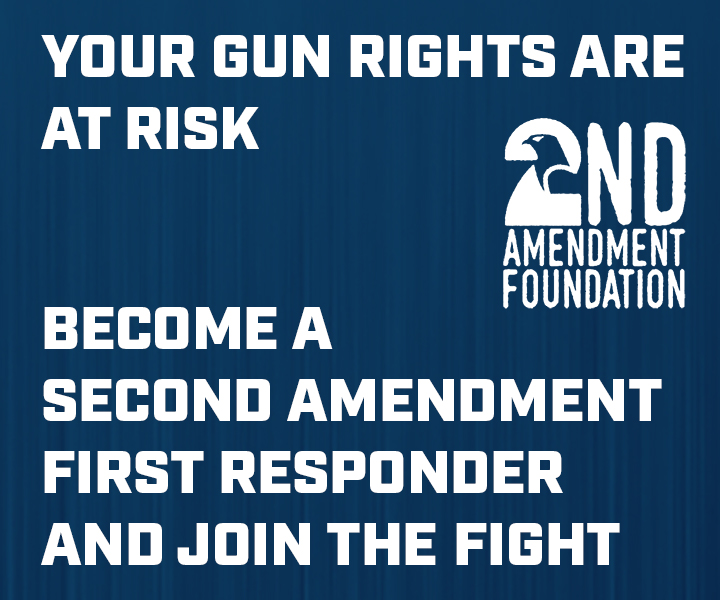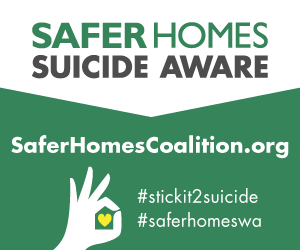By Dave Workman | Senior Editor
Women make up the fastest-growing demographic in the shooting community and a panel at the 33rd Annual Gun Rights Policy Conference in Chicago left no doubt about why that is.
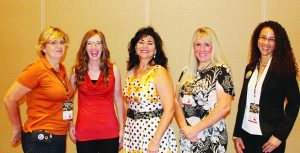
Suffecool, Malone, Todd, Sandoval and Cade
The discussion, led by Cheryl Todd, co-host of Gun Freedom Radio, told the audience of rights activists from across the country that women have concluded that they do not need anyone’s permission to be armed. She went on to criticize the sometimes condescending attitudes she has encountered from males about learning to use and defend herself with firearms, and she had plenty of company.
Joining Todd on the stage were Sarah Cade, a team leader with the Minnesota Gun Owners’ Caucus, Rachel Malone, operations director for Texas Firearms Freedom; Robyn Sandoval, executive director of A Girl and a Gun Women’s Shooting League and Amanda Suffecool, with Realize Firearms Awareness Coalition.
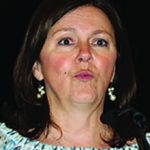
Laura Carno
Cade promoted outreach by identifying people with potential, and take their advice, allowing them to change ideas.
Her observations were amplified by Suffecool’s remarks about having seen a shift in the firearms industry to accommodate the increasing numbers of female shooters. Her own career in engineering has also seen a shift, she recalled, toward accepting women as equally talented, and that can translate to attitudes on the gun range.
“For a while,” she recalled, “women didn’t get to play.”

Jim Irvine
But in recent years, more women are competing, even in three-gun matches, and that provides an opening for women to speak to other women and spread a pro-rights message. Suffecool said things have changed to the extent that “we own it. We’re speaking.”
Sandoval declared that she is “taking the title of mom back” from anti-gunners at Moms Demand Action. She is a mother, and she does not care to have that identity usurped by an organization that seems determined to restrict her rights.
The title is “far more personal” to her, as she related the fact that her daughter is fighting cancer. Being a mother doesn’t get any more personal than that.
Malone, who lost a job with the Republican Party in Texas, is now working for Gun Owners of America, and she is outspoken about Second Amendment issues.
“We’re talking about gun rights,” she observed, “and that gives me a tool. Gun rights protect us.”
She said the Second Amendment is a defense against a tyrannical government, and it is the right that protects all the other rights.
“Gun rights bring us together,” Malone stated.
She reported that in Texas, the notion of “constitutional carry” (without a permit) s gaining momentum and more people are accepting the idea.
Arming school staff
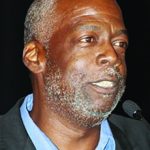
Rick Ector
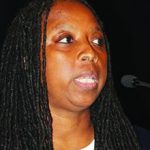
Rhonda Ezell
Jim Irvine, president of the Buckeye Firearms Association and a driving force behind the FASTER (for Faculty/Administrator Safety Training & Emergency Response) program that provides training for teachers and administrators in public or private schools.
He was joined at the podium by Laura Carno, founder of Coloradoans for Civil Liberties, who opened the discussion by noting that there are lots of myths about armed school staff. She said there are currently 37 states that have some kind of lawful path to allow for armed staff.
Carno said Colorado was the first state to fully implement the FASTER program, and she reported that by the end of 2018 there will have been four classes in the Centennial State.
Not all states utilize laws that allow armed staff, she said. She also noted that nobody is arming anybody. The FASTER program trains armed teachers; nobody is arming them, she assured.
She also said nobody is requiring teachers to carry firearms. This is a voluntary program.
A third myth is that police responding to a school shooting will not know who the “bad guy” is, and the FASTER training includes how to avoid such problems.
Irvine said the program’s goal is to make schools so safe that “some coward who wants to kill people will never even try it.”
“We need to understand that more important than the number of people killed (in a mass shooting) is where they’re killed,” he stressed.
School shootings get far more attention than other types of shootings. The battles that gun rights advocates fight are largely defined by where they happen.
“We protect things of value,” Irvine noted.
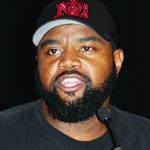
Kevin Dixie
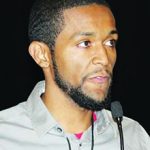
Marcus A. Weldon
As he has noted in past presentations, the FASTER project had a slow start but the first class was filled in 24 hours after the school attack in Parkland, FL, and they added five more classes in the wake of that tragedy.
In the past 5½ years, the program has raised more than $1 million to provide the training. There are now “Level 2” courses in addition to the initial course, and he said FASTER is looking to go to Texas and Arizona and other states. He is working on getting some federal funding, though that may be difficult.
“The demand is there,” he stated.
Carno and Irvine were followed by a panel discussion on the Outreach Initiative, which is working to bring firearms training and Second Amendment awareness to the minority community. The panel included Rick Ector, founder of Legally Armed in Detroit; Rhonda Ezell, lead plaintiff in Ezell v. Chicago; firearms instructor Kevin Dixie at No Other Choice, and Marcus Allen Weldon, author of The Santa Shooter.
Ector was inspired to “make a difference” by a crime in his city. He took firearms training, became an NRA-certified instructor and eventually a Training Counselor, who trains other instructors. He has been offering free firearms training to women annually for a few years and this year some 700 women turned out for a one day event.
“It’s all about empowering those people who are the most vulnerable,” he stressed. “We need to be there and to support them.”
Ezell recalled her adventures with the City of Chicago and how she became the lead plaintiff in the SAF case that challenged the city’s gun control law after losing in the Supreme Court. She said the problem in Chicago today is “gang violence, not gun violence.”
She also accused the mainstream media of being dishonest, while wealthy anti-gunners can preach gun control while enjoying armed security.
“We will continue to make our voices heard,” she said. “We are here and we are not going away.”
Dixie is from St. Louis, and he discussed perception in terms of being a Second Amendment activist. He offered advice on “how to arm your arsenal better.” This alluded to the ability of gun owners to tell their story and make their arguments.
He talked about getting passionate about the battle by discussing a community in Oklahoma that had been destroyed in 1921, and an earlier slaughter of African Americans who were trying to flee into Missouri during what was called by historians a “race riot.”
Dixie also objected to the terms “gun violence” and “black on black crime.” He said these refer to “violence” and “crime.”
Back to relate his story of having to fire in self-defense in 2014, Weldon recalled the incident in Detroit that nearly landed him in prison, and did cost him time in jail. He was ultimately exonerated three years later of several felonies but his gun was never returned. He had shot two individuals while wearing a Santa outfit.
He underscored the importance of having insurance for self-defense because defending one’s self in court can empty a bank account fast. His case cost some $45,000, he indicated.
Weldon also noted that some of the witnesses vanished, and one apparently fled the country.
“The process is something that I wouldn’t wish on anyone,” he said.
Assault Weapons ban
Rounding out the first afternoon were Edwin Walker with U.S. Law Shield, who discussed attempts to ban so-called “assault weapons,” and SAF’s Alan Gottlieb, with a discussion about the 2018 elections.
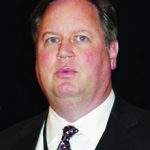
Edwin Walker
Walker recalled the 1994 Clinton ban on semi-auto rifles, which expired in 2004 and was not renewed by Congress. But there is a new proposal, HR 5087, which is sponsored primarily by Democrats. He noted that “a lot of people don’t know about it” but it is a “perfect example of the brazenness” of people in Congress who want to eliminate Second Amendment rights.
Unlike the Clinton era ban, this new proposal is “much, much worse” and if passed, it would become permanent. It is nearly all-encompassing, identifying all kinds of guns that would be defined as “assault weapons,” including several semi-auto shotguns.
Since 2004, there have been many failed attempts to revive the ban, and he predicted that HR 5087 would also fail, but would be reworked and reintroduced. One thing Walker noted is that the guns targeted by such legislation are wrongly identified as “weapons of war.” But, he said, they are not weapons of war.
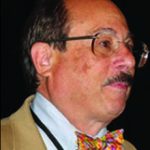
Alan Gottlieb
“We must reclaim the language,” he said.
Walker cautioned that the best way to stop anti-gun legislation is to stop anti-gun politicians.
Wrapping things up, Gottlieb warned that anti-gun politicians believed heading into the elections that the momentum has shifted to their side. He cited the surge in advertising that involved taking positions on gun control, and he urged the audience to “step up our involvement” in the elections.
Advancing Gun Rights
The second day’s session began with a panel discussion on advancing the gun rights message, featuring five veterans of the Second Amendment movement.

Herb Stupp
Leading off was Herb Stupp, a director of the Citizens Committee for the Right to Keep and Bear Arms and a media professional, who quickly advised the audience that when dealing with the media, find one person in a news organization who is fair and can help you “navigate.”
He criticized media bias in the New York Daily News and other publications, and he suggested that the media does not understand firearms. News organizations are shrinking and that compounds the problem because they do not have as much original reporting, being done by staff writers.
Stupp suggested appealing to a news organization’s sense of fairness and then cultivate relationships with news organizations. He also advised people to identify a newspaper’s ombudsman, and invite reporters to shooting events.

Valinda Rowe
Valinda Rowe, a spokesperson with Illinois Carry, followed with the observation that the Gun Rights Policy Conference is “a prime example of advancing our message.”
“We share the message wherever and whenever possible,” she remarked.
She encouraged conference attendees to become sources of information for reporters and to share the gun rights message with the public.
Noting that the Moms Demand Action group has “jumped into this full force,” Rowe recalled that in the beginning, members of that group “were everywhere.”
“They were effective,” she said. “It does not take a majority to prevail.”
Derek LeBlanc, president of Kids SAFE Foundation in Eugene, OR, looks at advancing gun rights by reaching out to the next generation. By offering firearm safety instruction, his group reaches youngsters who grow up in homes where guns may not be present, but who may be exposed to guns in a different setting.
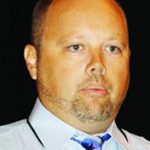
Derek LeBlanc
“We’ve reached over 5,000 kids,” he revealed. “We’re teaching kids safe gun handling.”
LeBlanc used his gun in a defensive situation a few years ago, and he has used that story to also reach people. He has used the gun, a pistol grip shotgun, during speeches to illustrate his points. Otherwise, he remains apolitical in his messaging.
As a result, many of the young people who get the training will become gun owners, he said.
“We have to figure out a way to broaden the base,” he stated. “My goal is to be a uniter, not a divider.”
Author Yehuda Remer discussed his books about guns for kids. He created the Safety On book series, which he says offer gun safety tips “in a cool way.”
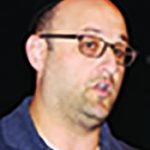
Yehuda Remer
“We must convey the importance of the Second Amendment and its meaning to our children,” he said.
He noted that “AR” doesn’t stand for “assault rifle,” when his 9-year-old knows that it stands for “awesome rifle.” Remer also said the Second Amendment is the most important amendment in the Bill of Rights, because if it is lost, “America will be lost, as well.”
Mike Piwowarski, host at Arms Room Radio, talked about “traditional media” and how to get the “gun message” circulated. He said activists need a “resume” that includes notes about having attended a Gun Rights Conference, a membership in a national and local gun rights organization and other details that establish credibility.
He encouraged people to contribute articles to local newspapers promoting gun ownership, such as opinion pieces about concealed carry.
Piwowarski also suggested reaching out to local television stations, providing a source of information. One way to do this is to sign up as a source at helpareporter.com, an online service that is used by journalists to find good sources for a variety of stories.
Heller, McDonald and More
Attorney David Hardy could not attend the conference, but he did provide a video history of how the battle for the Second Amendment reached the courts and was finally argued before the Supreme Court.
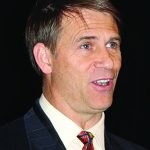
Sean Brodale
Hardy identified the attorneys and scholars who were involved in that process, and credited the Second Amendment Foundation for holding scholar conferences to discuss work on the amendment. Participants published in smaller law reviews until the late Don Kates was able to publish an article in the Michigan Law Review that got the attention of some high profile academics including Sanford Levinson, who published the famous article, entitled “The Embarrassing Second Amendment.”
All that work ultimately led to the first Heller case, won in 2008, that established the amendment as protective of an individual right. That opened the doors for SAF to file a challenge to Chicago’s handgun ban in the McDonald case, which they won.
Immediately following Hardy’s historical recollections, a three-doctor panel from Doctors for Responsible Gun Ownership—a SAF project—took the stage to discuss dealing with anti-gun medical professionals.
Sean Brodale, an emergency room physician, noted that “year after year, DRGO has brought to light the bias” that has been showing up in the medical profession. He criticized doctors who have used their profession to practice politics, and in recent times, some have been trying to discredit President Trump to re-ignite their gun control agenda.
He cautioned against medical journal articles that have a “pretty strong anti-gun-rights bias.”
Brodale estimated that there are some 100 million gun owners in the country, but there are only 6 million NRA members.
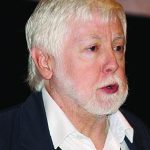
Robert Young
“We recognize that the public has a perception out there that doctors have a lot of education, they should be looking out for their patients, and they should be giving out the right information, but they don’t,” he observed. “This is our mission at DRGO, to serve as a guard against bias, policy directed pseudo-science that would hinder gun ownership under the guise of legitimate science.”
He was followed by Dr. Robert Young, an author and psychiatrist who noted that according to the FBI crime data; there are “well under 100 fatalities” annually in what the agency considers a mass shooting. That excludes domestic violence cases where families might be involved; situations that “really don’t fit” in the mass shooting scenario.
“This represents one half of one percent of all homicides,” he noted. “Perpetrators can be of any age or ethnicity. However, they are mostly white males, although not always. The DC sniper and Navy Yard shooters were both African-American.”
Young profiled mass shootings in detail, and said they are typically “in the attacker’s home turf.” He noted that it takes careful planning to carry off a mass shooting, and he stressed that “these folks know what they’re doing.”
“One thing that is consistent, though is that they always pick presumably gun-free zones,” he stated.
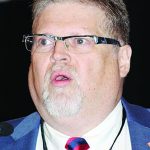
John Edeen
Dr. John Edeen, a pediatric surgeon, discussed trauma medicine in schools. His discussion touched on finding out what the plan was at schools for responding to an active shooter incident. His presentation focused on responding to an incident and providing immediate care for shooting victims.
He also discussed the FASTER program explained earlier in the conference. There are segments of that program that focus on first aid, dealing with wounds and saving lives.
His challenge to the audience was to find out if their local schools have a plan.
Knife Rights
Doug Ritter, founder and CEO of Knife Rights, noted that for the first time, his movement had gotten serious coverage from the Washington Post, which published a front page story on the movement.
However, he complained that the reporter “took a number of swipes at knife rights and used all the intellectually dishonest tricks of his trade to bias the article against us.”
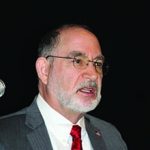
Doug Ritter
Ritter and his organization have been fighting to repeal or amend knife laws all over the map. Over the course of his activities, there have been 29 pieces of legislation that repealed knife laws in 21 states, and he is working on a repeal of the 1958 federal switchblade act.
Knife Rights is actively opposing a Senate bill called the Interstate Transport Act.
“We need to stop this bill,” Ritter said. “It is a terrible bill for gun owners.”
He also stressed that “you cannot stop fighting.”
Ritter was followed by Lennie Jarratt from the Heartland Institute, who discussed school safety and revealed that large numbers of parents in urban school districts do not believe their local schools are safe.
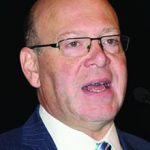
Todd Rathner
He reported that 21 percent of students are bullied each year, but that this seems to take a back seat to news about school shootings. He said 12.2 percent of all students everywhere are bullied. He discussed statistics for Chicago schools, and said the same thing happens in other districts.
Jarratt accused the media of ignoring bullying but highlighting incidents of school shootings. Yet, a high percentage of school shooters had been bullied.
He discussed “child safety accounts.” This provides an opportunity for students to escape unsafe situations in their schools.
“There’s no one single solution,” he acknowledged.
LGBT gun rights
Once again, gun rights in the LGBT community was on the agenda, and Nikki Stallard with the California Pink Pistols and Erin Palette, creator of Operation Blazing Swords, presented the subject, noting that “without the natural right of self-defense that the Second Amendment recognizes, our right to our very lives is illusionary.”
Stallard explained that believing in the Second Amendment right to keep and bear arms applies to everyone, gay or straight.
“What really matters,” Stallard observed, “is the content of a person’s character.”
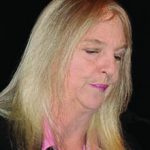
Nikki Stollard
She acknowledged that “overall, the LBGT community is anti-gun.” That community believes in non-violence, but June 12, 2016 may have changed that with the attack on the Pulse nightclub in Orlando. A radical Islamist, Stallard recalled, entered the club and opened fire, killing 49 and wounding even more.
“The Pulse nightclub was the 911 wake-up (call) for the gay community,” she noted.
While a majority of the gay community remains anti-gun, roughly 30 percent of gays are now pro-Second Amendment, according to Stallard, who noted that “armed gays don’t get bashed.”
Palette announced that henceforth, the Pink Pistols have merged with Operation Blazing Swords, and that she is the coordinator. That means the merged organizations are now the largest gay pro-gun group in the country.
“With this merger,” Palette said, “we have now become the organization that I hoped we could be.”
This allows Blazing Swords to provide training, education and outreach, and Pink Pistols being a program for community involvement, mutual support and continuing education. As Palette observed, “the most powerful sword is the one wielded by two hands.”
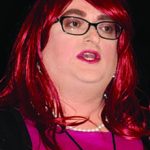
Erin Palette
They were followed by a presentation from Todd Rathner with the NFA Freedom Alliance, with information on the National Firearms Act, which he called “one of the single dumbest gun laws ever passed in this country, and that’s saying something.” Under the NFA, people can become criminals by simply putting some guns up to their shoulders because of all the confusing regulations.
The newest problem facing gun owners, he intimated, is that the Bureau of Alcohol, Tobacco, Firearms and Explosives is “about to turn a piece of plastic into a machine gun.” He was talking about “bump stocks,” which have been demonized since the Las Vegas mass shooting, the only time one of these devices has apparently been used in a crime.
But during the Obama administration, ATF ruled that the bump stock was not a machine gun.
“Just when you thought we were winning, we’re losing,” Rathner said, “and we’re losing our minds.”
The NFA Freedom Alliance submitted a 17-page objection to the proposal to re-classify bump stocks, he recalled. To fight a reclassification in court will take time and money, he said.
“This battle for our rights will never end,” he said. “It’s a lifetime commitment.”
He also discussed silencers. He said Bloomberg-funded anti-gunners have been busy on Capitol Hill, and he declared the Hearing Protection Act dead, blaming “squishy Republicans.”
Rathner said the next thing that anti-gunners will come after is exploding targets.
“Their strategy is to take the fun out of shooting,” he asserted. “This is a shooter harassment effort. We must fight them on every front.”
Using the ‘New Media’
A four-man panel next talked about using “new media” to advance gun rights, and podcaster Paul Lathrop reminded the audience up front that “guns don’t have rights, these are human rights.”
He noted that the “new media” isn’t really new, because blogs have been around since the mid-1990s. He said the first ten amendments to the constitution are what define human rights. The most important of these are the First and Second amendments.
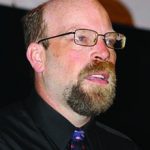
Paul Lathrop
After asking for a show of hands, it was obvious that the audience paid more attention to “new media,” including blogs and YouTube programs rather than the traditional evening news broadcasts from the networks. Lathrop referred to them not as the “old media” but the “legacy media,” and he declared them “nearly dead.”
“It’s because of people like you,” he said.
Lathrop explained how people can get their own podcast for about $30, and he contended that “we are making a difference.”
“You can become huge doing this,” Lathrop said.
Charlie Cook, the YouTube host of “Riding Shotgun with Charlie” and “The Gun Gram” followed with an explanation about how he produces videos. He started by making videos with his cell phone and eventually with cameras. The videos taped on his phone feature him shooting guns to music.
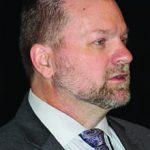
Charlie Cook
A firearms instructor, Cook makes sure that he practices good trigger control. He suggested making videos of things that people find interesting.
He creates and edits his videos and posts them online. He calls himself a “one-man operation.”
“Your first videos are not going to be great,” he cautioned.
But with time they will improve, and that is what other people breaking into social media will find, as well.
“My ultimate goal is to bring fun ownership to gun ownership,” he said.
John Richardson, author at “No Lawyers, only guns and money” blog, said “we are in a culture war. Everything we hold dear is under attack. It’s under attack by the well-financed anti-gun lobby. They have the money and they control the airwaves and social media…Nothing but our personal destruction will satisfy them.”
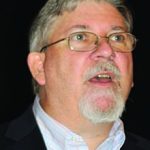
John Richardson
In his previous appearances at the conference, he has tried to take a kinder, gentler approach. But not anymore, he said.
“We are all warriors in this culture war, or we wouldn’t be in this room,” he said, calling the audience the “special forces” of the gun rights movement.”
Richardson recalled how activist gun owners used the internet and social media to spread links to information about 3D printing.
He blasted hypocrites who push gun control while enjoying the security of armed bodyguards, while also criticizing “gun free zones,” which he said are “nothing but hunting preserves for psychopaths,” a statement often used by legendary firearms instructor Massad Ayoob.
Rounding out the panel, Don Irvine, chair of Accuracy in Media, reminded his audience that they are “the true hardcore patriots.”
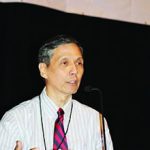
Don Irvine
He said podcasting is growing. There are more than a half-million podcasts now available and more seem to show up all the time, covering all kinds of subjects. The reason for increasing popularity is because “we are a mobile society,” Irvine observed.
He discussed different podcast options, adding that in less than a year, he’s had more than 3 million views on his own daily podcast. An important aspect of this is that a lot of the content can be shared, and that firearms people have a lot of information.
“But we have to go out there and educate others,” Irvine stated.
He suggested taking videos of left-wing anti-gunners and then sharing those videos. According to Irvine, “there’s nothing more damning with these people than to hear their own words. Just let them speak…They’re their own worst enemy when it comes down to that.”
The Last Word
Wrapping up the 2018 Gun Rights Conference, Alan Korwin, author and consultant with the Jews for the Preservation of Firearms Ownership, talked about “The Jihad Against Your Guns.’
He began by providing tips on semantics, as he has done at past conferences. Instead of talking about “gun rights,” he suggested changing the term to “pro rights.” That would, he explained, make the opposite side “anti-rights.”
“Who wins that argument,” he asked. “You win on words.”
“They want you to talk about gun violence. There is no such thing,’” he added. “You mean crime. It’s crime we’re fighting. It’s criminals we’re fighting.”
He also said anti-gunners and the media typically cannot define what an “assault weapon” is.
“Assault is a kind of behavior,” Korwin said. “It is not a kind of hardware. It’s something found in every household.”
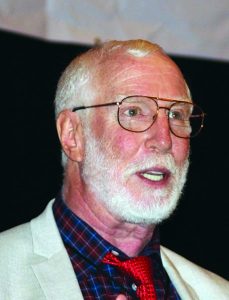
Alan Korwin
Another term he said to change is “shooter.” He said the proper term is “murderer.” By so doing, the media denigrates shooting, which is the second most popular activity in the United States, he said.
He also said the news never reports that guns save lives, that guns are used to prevent crime, or that guns are why America is free, or that guns are fun. He called this a “100 percent error of omission.”
Korwin discussed a recent meeting he had in which they discussed “what is America?” It’s a question without an answer, he observed. But there are some principles that stand out and are the reasons that people come from all around the world to be here.
The American way is hard work and keeping ownership of the products of that work. Each citizen owns the fruits of their own labor.
“You and you alone are responsible for you,” he said. “The king doesn’t own you. The state doesn’t own you. You own you.”
He noted later that people who reject America’s core values are the extremists, not average citizens, who are centrists.
“Left wing extremists are calling the moderates extreme,” Korwin stated, “and the media helps them sing that song. Only a vile and corrupt media could see it otherwise, and then promote an upside down cake of the truth.”
Korwin closed by observing that if something “maximizes freedom, it’s good.”
“The Founders knew that,” he said. “That’s what got us to this great pinnacle of success from which we are now slipping. If it would do good, but doesn’t maximize freedom, it must be rejected. If government can take action, but has no authority to do so, it must be rejected.
“There’s always another way,” he added: “The American way.”
Next year’s Gun Rights Policy Conference will be held in Phoenix, AZ. Details will be available in 2019.

